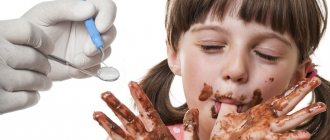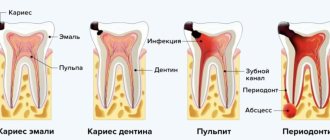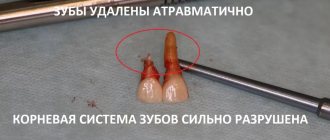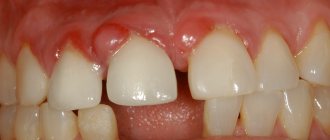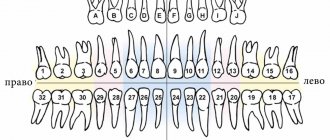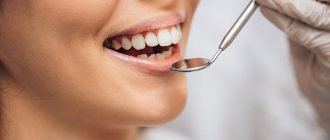Pulpitis is an inflammation of the internal structure of the tooth - the neurovascular bundle. In the vast majority of cases, this disease is caused by caries - many parents believe that it is not necessary to treat it, because baby teeth must be replaced quickly. However, this statement is incorrect, since caries, which is not addressed in time, causes tooth destruction and inflammation of the pulp.
Primary molars, especially the lower ones, are more susceptible to this. This is due to the relatively thinner enamel - the infectious process reaches the internal structures of the tooth faster. For the same reason, pulpitis in children develops much faster than in adults.
Among the causes of the disease are also injuries, including those associated with improper treatment of enamel caries, when the doctor accidentally exposes the pulp during tooth preparation.
Symptoms of pulpitis in children
Symptoms and treatment of pulpitis in children vary depending on the form and severity of the disease. Pulpitis has two forms - acute and chronic. The first is relatively less common, but the symptoms in this case are more pronounced. There are two stages of the inflammatory process:
- Serous. The pulp becomes inflamed, and the tooth canals are filled with serous fluid. The child experiences severe pain in the tooth, which intensifies at night or with exertion—chewing on the side of the causative tooth. Often there is only one episode of pain. Within a few hours, the inflammation moves into the next stage.
- Purulent. Purulent contents begin to form in the root canals of the tooth. The severity of this stage depends on several parameters: the state of the child’s immune system, the activity of microorganisms, the state of the root system of the tooth, and the age of the young patient. The pain can be tolerable if the child’s immunity functions normally, microorganisms multiply slowly, and pus escapes through the carious cavity of the tooth. However, more often there is quite pronounced pain, prolonged attacks, and the unpleasant sensations radiate to other teeth. They intensify with mechanical, temperature effects on the causative tooth; the child’s appetite worsens or he refuses food altogether. In rare cases, there is an increase in body temperature and enlarged lymph nodes.
It is worth noting that chronic pulpitis can be asymptomatic, and there are often cases of the development of an inflammatory process in a previously filled tooth. The fact is that it can be quite difficult to properly treat the carious cavity of a child’s tooth before filling it - this is due to the emotional state of the patient and the forced haste of the dentist. This leads to the fact that the filling is installed in a cavity that is not sterile or is not sufficiently dried from saliva - pathogenic microorganisms continue to multiply, penetrating deep into the tooth and causing pulpitis.
With chronic pulpitis, pain can only occur when food debris gets into the carious cavity. The gangrenous form of the disease is characterized by the appearance of pain some time after eating hot food, a feeling of fullness and heaviness in the tooth, and bad breath.
When should you visit a dentist?
The sensitivity of the neurovascular bundle of a tooth in a child is lower than in an adult, so the symptoms of its inflammation may be erased or absent altogether. It is important to contact a pediatric dentist when the first symptoms of caries appear - a dark spot on the tooth, or the child complains of pain. You should hurry up with your visit if:
- severe pain;
- increased pain when eating hot or cold food/drinks;
- bad breath;
- elevated body temperature;
- inflammation of the gums around the tooth;
- darkening of the enamel.
Pulpitis of a baby tooth: is it necessary to treat?
Treatment of pulpitis in children should be carried out in any case and as soon as possible. It is unacceptable to wait for a baby tooth to fall out, stopping only the symptoms. Failure to provide assistance to a child can result in serious complications - periostitis (in common parlance - gumboil), periodontitis - inflammation of the periodontal tissues. In addition, the infectious process in the neurovascular bundle of a baby tooth can spread to a permanent tooth when it erupts.
If a long time must pass before the eruption of a permanent tooth, premature destruction of a baby tooth due to pulpitis can lead to malocclusion - displacement of healthy teeth in a row, change in their position, which will require complex orthodontic treatment in the future.
If a baby tooth with pulpitis is soon to be replaced by a permanent one, the doctor may resort to extraction. In any case, this disease should not be ignored.
Reviews
After reading reviews about the treatment of pulpitis at the Natadent clinic, you can be sure that our little patients and their parents are always satisfied with both the treatment process and the quality of the result.
Don't forget to leave your review, we will be very grateful!
LEAVE FEEDBACK
Treatment methods for pulpitis
The tactics of a pediatric dentist depend on the condition of the child’s tooth and dental system, the severity of his condition, and whether there are concomitant diseases of the oral cavity. If the pulpitis is very severe and there is a risk of a threat to its health, the tooth must be removed. However, in the vast majority of cases, it is possible to keep the tooth permanent until its natural replacement, since removal can lead to disruption of the bite or the position of the remaining healthy teeth in the row.
Traditional treatment of dental pulpitis in a child consists of devital amputation of the pulp and is carried out in several visits. The stages of treatment of pulpitis in children are presented as follows:
- The doctor opens the tooth cavity, removes carious tissue, and applies a paste to devitalize the pulp. It is designed to “kill” the neurovascular bundle and eliminate pain. If the paste contains arsenic, it is used for a period of 1-2 days; if an arsenic-free product is used, it is used for at least 7 days.v
- The second visit involves placing a special mixture into the canals for tissue mummification - a resorcinol-formalin mixture is used.
- The third visit is to fill the diseased tooth.
This method is practiced much less frequently today, since there is a possibility that the infectious process will persist in unsealed tooth canals - mummification of the pulp involves its “drying out” and the formation of voids in which pathogenic bacteria continue to multiply.
The modern approach to the treatment of pulpitis of primary teeth in children is extirpation - complete removal of the inflamed pulp. This can be done with or without prior killing or devitalization of the pulp. In many cases, devitalization is more preferable, since it relieves the child of any unpleasant sensations during the removal of the neurovascular bundle.
After the tooth canals are freed from pulp and carefully processed, the doctor fills them with an anti-inflammatory paste - it tends to dissolve along with the roots during the natural change of teeth to permanent ones. For this purpose, zinc eugenol paste is often used. This method of treatment is comparatively more effective, and if the canals are treated with the utmost care, the infection will not reactivate. Other modern methods of treating pulpitis in children include vital amputation. It consists of preserving the viability of part of the pulp - the upper part of the nerve is removed under local anesthesia, and a medicine with an antibacterial and anti-inflammatory effect is applied to the remaining root pulp. The drug closes the lower part of the neurovascular bundle without affecting its viability, and the tooth is subsequently filled.
Reviews from parents and impressions of children
Novel
I didn’t even know that children can have pulpitis. But one day Varya got up in the morning with a swollen cheek. The tooth didn’t even hurt, but the doctor diagnosed pulpitis. We treated him in several stages. They put on a paste that does not prevent the roots from resolving. Now we take even more careful care of our teeth.
I put Aza&Buka:
5
Varya
Svetlana
At night, Ignat woke up in tears of pain. The tooth hurt very badly. Early in the morning we made an appointment for an emergency appointment at Azabuka and at half past nine we were already at the doctor’s office. It turned out that there was pulpitis of a baby tooth. He was treated with nitrous oxide. Ignatik watched cartoons, and the doctor saved our tooth. Everything ended well, thanks to the doctors!
I put Aza&Buka:
5
Ignat
Egor Alekseevich
Azabuka's doctors diagnosed Nikita with pulpitis during a routine preventive appointment. How is that possible?! And the tooth didn’t even hurt. They treated me in one visit using some cool technology. Now everything is all right.
I put Aza&Buka:
5
Nikita
Treatment of pulpitis of teeth with unformed roots
The root system of a baby tooth is formed over a long period of time after eruption, so there are often situations when caries begins to form on a tooth whose roots have not yet closed the apex. This leads to some treatment difficulties:
- short roots and wide channels;
- the upper part of the root is the “growth” zone, injury to which is an obstacle to root formation;
- the likelihood of infection of the permanent tooth germ;
Treatment of pulpitis of teeth with immature roots in children requires special care. The doctor must carefully monitor that the filling material is not carried beyond the expansion of the root apex. It is worth noting that complete removal of the pulp and treatment of the canals is impossible - the optimal solution here is vital and devital extirpation. Pulp amputation may also be used. The biological method, which consists in preserving a viable pulp and relieving inflammation, is also practiced quite often. Its essence is to prepare the tooth, apply a medicinal paste with calcium hydroxide, after which the tooth is filled with temporary material. A few days later, if there are no complications and the unpleasant symptoms disappear, the doctor installs a permanent filling.
How to prepare a child for treatment?
Treatment of pulpitis of primary teeth in children is a rather complex task, so it’s great if the child is already familiar with the dentist’s chair. The first visit should be preventative - to familiarize yourself with the office environment, the doctor, and the instruments.
Also, the task of parents is to psychologically prepare the child. Required:
- talk to your child about doctors in a positive way - tell them that the dentist treats teeth and makes sure they don’t hurt;
- play dentist with toys and other family members;
- avoid mentioning pain or unclear, scary terms;
- do not deceive the child - explain that dental treatment may not be very pleasant, but it will not last long and the tooth will no longer hurt;
- remain calm, act gently but confidently if the child resists treatment;
- choose a suitable time for visiting - it is better in the morning, when the baby is alert and active;
- take a toy with you to calm the child;
- give the doctor the opportunity to establish contact with the small patient - do not rush him;
- Do not scare the child under any circumstances, do not threaten, do not blackmail.
If the situation cannot be controlled completely, you will have to reschedule the appointment for another day. However, the disease should not be ignored - treatment of pulpitis of baby teeth in children must be carried out one way or another. In special cases, treatment under general anesthesia may be considered, but this should be discussed with your doctor.
Treatment with a smile, no stress for the child, no tears
Pulpitis of primary and permanent teeth in pediatric dentistry is quite common; approximately 90% of children with advanced caries suffer from symptoms of this disease. Children's pulpitis is accompanied by excruciating toothache, which deprives you of joy. The use of painkillers will not solve the problem, so the only correct solution is to visit a dentist. The Novodenta dental clinic offers the services of a pediatric dentist who will not only treat pulpitis or periodontitis, but will also find an approach to every little patient.
Possible complications of treatment of pulpitis in children
Child anxiety is the main difficulty faced by pediatric dentists. Due to the emotional state of the patient, the specialist has to rush or fails to perform the manipulation carefully, which may result in the following complications:
- the paste is not applied to the nerve - this leads to the fact that the pain does not subside, and the procedure must be repeated again;
- burn of the gums by the paste due to its close location to the tooth;
- bleeding when processing unformed roots;
- perforation of the root of a baby tooth;
- breakage of instruments in the root canal.
You can avoid possible complications or minimize the likelihood of problems arising by normalizing the child’s psychological state and contacting an experienced, qualified doctor.
Prevention of pulpitis in children
Treatment of pulpitis in permanent teeth in children, as well as their “predecessors” - baby teeth - is a rather complex procedure that may require several visits to the doctor. Preventing a disease is easier than treating it - all you need to do is pay attention to hygiene procedures and teach your child how to brush their teeth correctly from a very early age.
It is also important to monitor the child’s diet - strengthen the enamel with solid foods (carrots, apples, etc.), provide a balanced diet to saturate bone tissue with minerals. It is better to limit sweets and give only water at night. Prevention of caries is the basis for preventing its complications, including pulpitis.
Indications for medicinal effects on the canals
The main method of endodontic treatment is mechanical cleaning of the canals with constant rinsing. Moreover, in some cases, dentists use medicinal preparations of various effects. These include the following diseases:
- acute form of chronic, traumatic, toxic or infectious periodontitis;
- chronic development of periodontitis with a predominance of anaerobic microflora, periapical defect of bone tissue or constant canal humidity;
- the need for endodontic treatment at the stage of incomplete root formation or its apex;
- traumatic damage to permanent or temporary teeth;
- perforation of the root wall, external or internal resorption.
